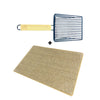Since May is National Foster Care month, we wanted to do a deep dive into what it means to foster a furry friend. Sadly, approximately 860,000 cats are euthanized in the United States. Next to adopting a cat, fostering one is a great way to ensure these numbers go down by making it easier to find more cats comfortable and loving places to call their fur-ever home.
What does it mean to foster? Fostering a cat means that you and your family volunteer to temporarily bring a homeless feline into your home until they are adopted. The timeline for fostering can vary from a week or two to years, depending on the situation.
Types of Fostering
Short-term: Depending on the rescue organization you’re working with, there are often opportunities to bring a cat into your home for a short time, even just a couple of weeks. These tend to be situations where the cat needs a break from the rescue because of a medical recovery. Bringing the cat into a more comfortable, homey situation may help them be less stressed and recover more peacefully.
Long-term: If the plan you work out with the rescue organization is for the cat to stay in your home until it’s adopted, you may be in for a long-term fostering situation. Or, the organization may ask you to commit to a certain timespan that can go for months or even longer. Examples of this may be if you foster a kitten who is not yet old enough to be spayed or neutered, or if you provide a quiet, safe home for a pregnant female to give birth.
Permanent and Hospice Cat Fostering: If a cat is in poor health or older and less likely to get adopted, the rescue organization you’re working with may set up a permanent fostering situation where they continue to offer supplies and medical care to help you take care of the animal.
Types of Cats to Foster
The type of cat and the condition it’s in will determine a lot about how your experience will be. Here are a few options you may be presented with:
· The cat is totally healthy, an average or young age, and has no health issues
· Cats that cannot live with another cat or any other type of animal
· Siblings or pairs of cats that are bonded and are best to stay together
· A cat that is recovering from a medical operation and will have special needs
· A pregnant cat that has a litter on the way
· A cat that needs socialization because they’ve gone through a traumatic experience, has a lot of stress from living at the shelter, or has not spent much time around humans
· A cat that is older or younger and need a special kind of care
· A cat with an infection or sickness that needs to be quarantined from other animals while they heal
Are you ready to become a foster parent?
Fostering a cat is no small commitment. Before deciding you want to take it on, it’s important to consider the space you live in, if you have other pets in the home, additional costs that the rescue organization isn’t able to pay for, and if you have the time to commit to a new furry friend. Even if the situation is temporary, you should think of it like you’re adopting a cat permanently in terms of logistics.
Prepping for Your Foster
Similar to adopting a kitten or cat, you will need various equipment and treats if you plan to become a foster parent. Check out our Kitty Kit post to learn more about some of the things you may need.
Fostering a cat is no easy task. We’re so incredibly grateful for the thousands of people who open their homes and hearts to help these amazing kittens and cats. Cheers to you!














